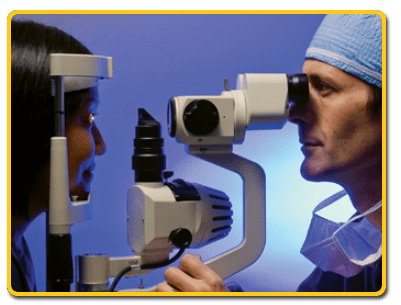LASER EYE SURGERY GUIDE

LASIK surgery is one of the most successful treatments available to restore diminishing vision. Successful laser eye surgery means saying goodbye to glasses, inserting and removing contacts, or viewing the world through a perpetual squint. Even so, it can be intimidating to submit oneself to a procedure if the options and methods aren’t thoroughly understood as a patient.
Laser eye surgery, commonly referred to as LASIK surgery, is designed to correct three conditions involving the cornea: myopia, hyperopia and astigmatism. However, in order to understand how the surgery works, it’s important to understand the human eye and the cornea’s role in the vision process.
The main parts of the eye responsible for vision include:
- Cornea
- Sclera
- Iris
- Lens
- Pupil
- Retina
- Vitreous
- Humor
- Optic Nerve
The cornea is the outer covering over the center of the eye. Its purpose is to refract, or bend, light through the pupil, directing it into the iris, and continuing through the lens and the vitreous. The refracted light lands as a sharp point on the retina, at the rear of the eyeball. The retina takes these light rays and using photoreceptor nerve cells, it translates them into electric impulses along the optic nerve, allowing the brain to form images. If the cornea is damaged, or misshapen in anyway, these images become blurred and distorted.
A distorted cornea can cause the following conditions:
- Myopia – nearsightedness
- Hyperopia – farsightedness
- Astigmatism – a condition where light fails to merge to a single point on the retina.
Laser eye surgery can usually remedy any of the above conditions. An optometrist or ophthalmologist will be able to confirm whether or not laser eye surgery is an option.
It is not an available treatment if:
- You are younger than 18 years old
- You are pregnant
- You are nursing
What Exactly Is LASIK Surgery?
LASIK surgery is a procedure to correct the shape of the cornea. From start to finish, the procedure lasts about 15 minutes. There are no stitches involved and improved vision is often noticeable within 24 hours.
The patient’s eye is completely numbed so that s/he will feel nothing but a slight pressure. The eye will not move during the procedure. Once the eye is properly numbed, the doctor will create a small “flap” which can be folded back to expose the cornea. The patient chooses whether the flap is created using:
- A small metal blade, called a microkeratome
- A bladeless process, called Intralase
Once the flap is folded back, a laser is used to reshape the cornea to the desired shape for optimal vision. There are two different guides that can be used as a model for the correct corneal shape:
- The patient’s current prescription
- A computerized topographic map of the eye, called CustomVue
Once the cornea has been repaired, the flap will be repositioned and the patient is free to leave.
Preparation for LASIK Surgery
- The patient needs to have a pre-operative exam to verify that s/he is a candidate for the procedure.
- Contact lenses should not be worn for at least a week prior to the pre-operative exam. This time period is even longer for patients using hard contact lenses.
- Patients must also refrain from wearing contacts prior to receiving laser eye surgery and this period of time will also depend on the types of lenses worn.
Post-Op Treatment For LASIK Surgery Patients
Patients will be given antibiotic and anti-inflammatory drops to be used for the week following the procedure. It is also important that patients wear dark lenses to protect the sensitive eye tissues from bright light. Rubbing the eyes is off limits so goggles may be worn at night to prevent irritating the eye tissues during sleep.
Within a week, a patient’s eyes should be fully healed – enabling them to enjoy a new ‘view’ on life.
To determine whether laser eye surgery is right for you, please contact us for a no-obligation exam and consultation. We’ll conduct a thorough and complete examination of your eyes to determine whether you are a good candidate for surgery.

